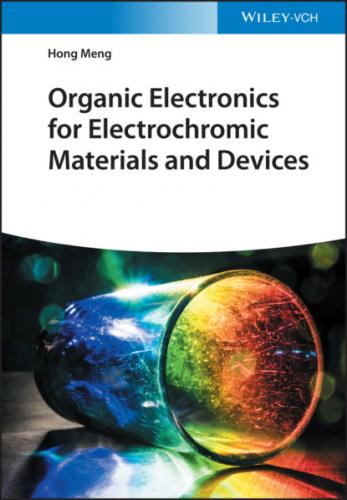References
1 1 Fletcher, S. (2015). The definition of electrochromism. Journal of Solid State Electrochemistry 19 (11): 3305–3308.
2 2 Camurlu, P. (2014). Polypyrrole derivatives for electrochromic applications. RSC Advances 4 (99): 55832–55845.
3 3 Wang, Z., Wang, X., Cong, S. et al. (2020). Fusing electrochromic technology with other advanced technologies: a new roadmap for future development. Materials Science & Engineering R: Reports 140.
4 4 Wu, W., Wang, M., Ma, J. et al. (2018). Electrochromic metal oxides: recent progress and prospect. Advanced Electronic Materials 4 (8).
5 5 Mortimer, R.J. (2011). Electrochromic materials. Annual Review of Materials Research 41 (1): 241–268.
6 6 Platt, J.R. (1961). Electrochromism, a possible change of color producible in dyes by an electric field. The Journal of Chemical Physics 34 (3): 862–863.
7 7 Hutchison, M.R. (1913). Electrographic display apparatus and method. US Patent 1,068,774, filed 29 July 1913.
8 8 Lehovec K. (1957). Photon modulation in semiconductors. US Patent 2,776,367, filed 1 January 1957.
9 9 Neff, V.D. (1978). Electrochemical oxidation and reduction of thin‐films of prussian blue. Journal of the Electrochemical Society 125 (6): 886–887.
10 10 Michaelis, L. and Hill, E.S. (1933). The viologen indicators. The Journal of General Physiology 16 (6): 859–873.
11 11 Schoot, C.J., Ponjee, J.J., van Dam, H.T. et al. (1973). New electrochromic memory display. Applied Physics Letters 23 (2): 64–65.
12 12 Garnier, F., Tourillon, G., Garzard, M., and Dubois, J.C. (1983). Organic conducting polymers derived from substituted thiophenes as electrochromic material. Journal of Electroanalytical Chemistry 148: 299–303.
13 13 Mengoli, G., Musiani, M.M., Schreck, B., and Zecchin, S. (1988). Electrochemical synthesis and properties of polycarbazole films in protic acid media. Journal of Electroanalytical Chemistry and Interfacial Electrochemistry 246 (1): 73–86.
14 14 Zheng, H.B., Lu, W., and Wang, Z.Y. (2001). Electrochemical and electrochromic properties of poly(ether naphthalimide)s and related model compounds. Polymer 42 (8): 3745–3750.
15 15 Oishi, Y., Takado, H., Yoneyama, M. et al. (1990). Preparation and properties of new aromatic polyamides from 4,4′‐diaminotriphenylamine and aromatic dicarboxylic acids. Journal of Polymer Science Part A: Polymer Chemistry 28 (7): 1763–1769.
16 16 Cheng, S.‐H., Hsiao, S.‐H., Su, T.‐H., and Liou, G.‐S. (2005). Novel aromatic poly(amine‐imide)s bearing a pendent triphenylamine group: synthesis, thermal, photophysical, electrochemical, and electrochromic characteristics. Macromolecules 38 (2): 307–316.
17 17 Arimoto, F.S. and Haven, A.C. (1955). Derivatives of dicyclopentadienyliron. Journal of the American Chemical Society 77 (23): 6295–6297.
18 18 Whittell, G.R. and Manners, I. (2007). Metallopolymers: new multifunctional materials. Advanced Materials 19 (21): 3439–3468.
19 19 Wade, C.R., Li, M., and Dincă, M. (2013). Facile deposition of multicolored electrochromic metal–organic framework thin films. Angewandte Chemie International Edition 52 (50): 13377–13381.
20 20 Hao, Q., Li, Z.‐J., Lu, C. et al. (2019). Oriented two‐dimensional covalent organic framework films for near‐infrared electrochromic application. Journal of the American Chemical Society 141 (50): 19831–19838.
21 21 Li, W., Ning, J., Yin, Y. et al. (2018). Thieno[3,2‐b]thiophene‐based conjugated copolymers for solution‐processable neutral black electrochromism. Polymer Chemistry 9 (47): 5608–5616.
22 22 Beaujuge, P.M. and Reynolds, J.R. (2010). Color control in π‐conjugated organic polymers for use in electrochromic devices. Chemical Reviews 110 (1): 268–320.
23 23 Jiang, M., Sun, Y., Ning, J. et al. (2020). Diphenyl sulfone based multicolored cathodically coloring electrochromic materials with high contrast. Organic Electronics 83: 105741.
24 24 Fred Schubert, E., Chapter 16. Human Eye Sensitivity and Photometric Quantities in Light‐Emitting Diodes, 2e. Cambridge University Press.
25 25 Kraft, A. (2018). Electrochromism: a fascinating branch of electrochemistry. ChemTexts 5 (1): 1–18.
26 26 Padilla, J., Seshadri, V., Filloramo, J. et al. (2007). High contrast solid‐state electrochromic devices from substituted 3,4‐propylenedioxythiophenes using the dual conjugated polymer approach. Synthetic Metals 157 (6–7): 261–268.
27 27 Hsiao, S.‐H. and Lin, S.‐W. (2016). Electrochemical synthesis of electrochromic polycarbazole films from N‐phenyl‐3,6‐bis(N‐carbazolyl)carbazoles. Polymer Chemistry 7 (1): 198–211.
28 28 Hassab, S., Shen, D.E., Österholm, A.M. et al. (2018). A new standard method to calculate electrochromic switching time. Solar Energy Materials and Solar Cells 185: 54–60. https://doi.org/10.1016/j.solmat.2018.04.031.
29 29 Fabretto, M., Vaithianathan, T., Hall, C. et al. (2008). Faradaic charge corrected colouration efficiency measurements for electrochromic devices. Electrochimica Acta 53 (5): 2250–2257.
30 30 Wei, Y., Zhou, J., Zheng, J., and Xu, C. (2015). Improved stability of electrochromic devices using Ti‐doped V2O5 film. Electrochimica Acta 166: 277–284.
31 31 Lampert, C.M., Agrawal, A., Baertlien, C., and Nagai, J. (1999). Durability evaluation of electrochromic devices – an industry perspective. Solar Energy Materials and Solar Cells 56 (3): 449–463.
2 Advances in Polymer Electrolytes for Electrochromic Applications
2.1 Introduction
The ionic conduction medium between the electrodes and electrochromic (EC) materials is an electrolyte, which is one of the most essential active components in electrochromic device (ECD). Electrolyte provides an indispensable role as the prime ionic conduction medium between the electrodes while preventing electron conduction between the two electrodes during EC operation. The important electrolyte properties greatly affecting the EC performance are the electrolyte ionic conductivity, ion dissociation, transport rate of ion through bulk and interface, and thermal stability [1]. Electrolytes were initially reported in the early 1970s, including ceramic, glass, crystalline, and polymer electrolytes (PEs). PE was first introduced by Fenton et al. in 1973 [2] and widely applied since 1980s [3]. In the past decades, PEs attracted much attention from all over the world's researchers due to their promising applications in electrochemical storage/conversion devices.
In general, electrolytes can be classified into PEs, liquid electrolytes, ceramic electrolytes, and solid inorganic electrolytes [4–6]. Briefly, PE is a membrane composed of a dissolution of salts in a polymer matrix with high molecular weight [7]. PE is widely applied in electrochemical devices such as solid‐state batteries and rechargeable batteries, ECDs, supercapacitors, fuel cells, dye‐sensitized solar cells, and EC windows. Technologically, PEs evolved from polymer, liquid ionic conductor and solid‐state
